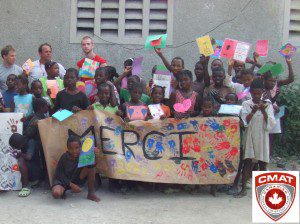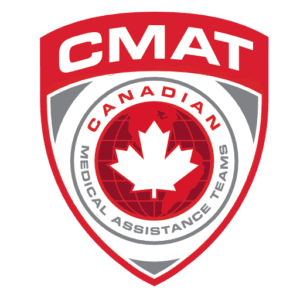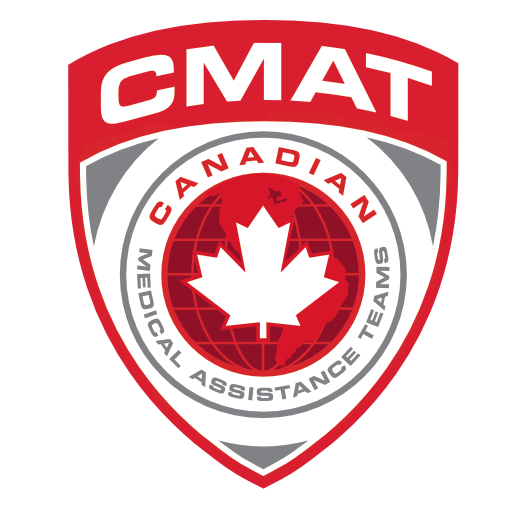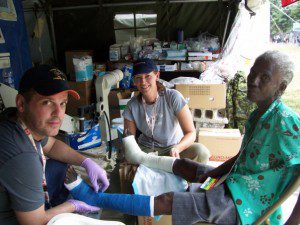Haiti earthquake – 6 months on

Children at a local orphanage send their thanks for helping CMAT to provide them with basic medical care.
July 12, 2010 – Today marks 6 months since the devestating earthquake struck Haiti, killing over 200,000 people and rendering well over 1,000,000 homeless. CMAT Executive Director Valerie Rzepka reflects on the organization’s response to this crisis.
Utilizing the principles of Sphere minimum standards in humanitarian response, this need was found in the city of Léogâne, the city closest to the epicentre, and approximately 35km southwest of Port-au-Prince. While awaiting the imminent arrival of CMAT Trauma Team 1 and the field hospital infrastructure, we partnered briefly with SARAid UK, who were conducting searches of buildings in the city of Port au Prince, and our team provided medical back up and support at L’Hôpital de la Paix.
Shortly after arriving, the 16-member trauma team established the CMAT Field hospital in Léogâne, a city of approximately 150,000, and the worst affected area with 80 to 90% of buildings damaged and no remaining government infrastructure. Nearly every concrete structure was destroyed. The damage was also reported to be worse than the capital. The military estimated that 20,000 to 30,000 people had died from the earthquake in Léogâne. People congregated in ad hoc squatter camps as relief took a long time to reach Léogâne.We set up camp in the school yard of the Louis Borno Primary School (GPS: 18.508363, -72.6286) along with an inflatable field hospital, pharmaceutical, medical and surgical supplies, and operating room capabilities. A generous donor donated a portable x-ray machine.
CMAT volunteers were able to treat over 300 patients per day including at least 10 to 12 orthopaedic surgeries daily, including a variety of traumatic injuries, such as serious fractures and dislocations, major and minor lacerations, complications from acute infectious diseases such as dehydration. In fact, before we were even fully set up and ready to accept patients, our first little one couldn’t wait to make his arrival known, much to the surprise and delight of his exhausted mother and the CMAT team. The healthy little boy was the first baby ever delivered in CMAT’s history.
From mid-January of this year, CMAT collaborated very closely with Canadian Forces, as we operated our field hospital in Léogâne. In the two short months that our field hospital was operational, our medical volunteers treated well over 10,000 patients, performed hundreds of surgeries, and delivered at least 10 babies.
The provision of this medical care was possible only through the selfless undertakings of our volunteers, and with the unprecedented support and protection of the Canadian forces: sailors from the HMCS Athabaskan, and soldiers from the Royal 22e Régiment “Van Doos”, who significantly contributed to CMAT’s safe operations in Haiti.
In late January, a group from Seattle arrived on-site, and assisted our volunteers in the CMAT Field Hospital. This was the birth of our new partner organization, International Medical Assistance Team (IMAT).
Transition to Primary Care
As the need for acute health care in Léogâne diminished in the months following the disaster, our responsibilities were successfully transitioned to partner organizations working in the community. CMAT and IMAT moved our operations to Pétionville (a suburb of Port-au-Prince), and into a partnership with the Jenkins/Penn Haiti Relief Organization (J/P HRO), staffing the health centre for an Internally Displaced Persons (IDP) camp located on a golf course ((GPS: 18.537244, -72.301551) which houses approximately 50,000 to 60,000 people.
Our volunteers continue to collaborate with J/P HRO’s international staff of volunteers, to assess and treat an average of 200 patients per day, and together have delivered nearly 120 babies since March.
Fundraising
In the period from January 12 to February 12, 2010, generous donors donated over $125,000 in individual charitable contributions. This amount was officially submitted to CIDA, under its ‘fund matching program’ with the hopes of having these funds matched to continue our project in Haiti. CMAT submitted a formal proposal to CIDA for funding in February.
Six months have now passed since the earthquake and CMAT has yet to receive a single penny in CIDA funding. Like the Canadian public, we believed that the individual charity is responsible for raising as much money as possible in a specified timeframe, at which point CIDA would directly match these funds back to the charity.
The funds we raised over the last six months have covered just over half our budget. We have been forced to dip into our emergency contingency savings in order to offset the balance of the ongoing expenses. As a grassroots organization, we are in the challenging position of trying to find a balance between the overall financial stability of our organization, and the overwhelming need in the communities we work with, and without the financial support of the Canadian government, it makes this challenge all the more trying.
In addition to monetary donations, which have been used to purchase needed medical supplies, drugs and other equipment for Haiti, CMAT received several generous in-kind donations, including a pallet of ready-to-eat meals, several cases of surgical equipment, a portable x-ray machine, international cellular roaming airtime, and the use of a large private airplane which airlifted our field hospital and equipment, and CMAT’s Trauma Team 1 from Toronto Pearson Airport to Santo Domingo, Dominican Republic. Words cannot express our gratitude to our generous donors for their ongoing support.
Overview
As National Chairperson of CMAT, I have never been prouder to be Canadian. Not enough is being said to give thanks to the first-responders to the Haiti disaster. Volunteers from our organization hail from across Canada. Members from Victoria, BC to St. John’s NF have taken time from their lives to help ease the suffering of the people of Haiti. They consist of a diverse group of doctors, nurses, paramedics, mental health workers, students and other non-medical volunteers who sacrifice their time to help others and in the case of the Haiti, expose their lives to imminent danger.
Scope of the CMAT Response – in the numbers:
• 10,000+ – The number of patients treated in CMAT’s Field hospital in Leogane.
• 200+ – the number of orthopaedic surgeries conducted in CMAT’s Field hospital in Leogane
• 14 – The number of babies born at the CMAT Field Hospital in leogane.
• 105 – the total number of volunteers sent by CMAT to Haiti
• 20 – The number of CMAT physicians and surgeons
• 7 – The number of CMAT nurse practitioners
• 41 – The number of CMAT registered nurses
• 29 – The number of CMAT paramedics
• 8 – The number of CMAT non-medical or student volunteers
CMAT and our volunteers continue to be at the ready in the event of another global natural disaster. We will be hosting two training sessions this fall, in Vancouver and Toronto. We invite you to join our Facebook Fan page, and watch our website for more information.






